One of my good friends,Dominic, recently asked me how to go about purchasing a home, his second investment property. In an instant, a variety of options crossed my mind; cash, traditional financing, non traditional financing in the form of hard money, and finally non traditional financing in the form of a seller held note.
I recently used the latter method (seller financing) to help structure a deal on a commercial building in Fishtown. Since then, I have learned that seller held note’s truly are the holy grail of financing an investment property. Think about it; you are able to 100% negotiate all of the terms of the note. When you go to a bank, they have strict credit requirements, loan to value ratios, and variety of other requirements which halt the majority of prospective borrowers. You can negotiate the following:
- Interest rate: Lender’s typically base their interest rates on Prime. You have access to that information as well, but you can add or subtract anything you want to that prime number – it’s all about what you negotiate and can get the seller to accept
- Loan to Value: Lenders typically are comfortable with LTV’s around 70-75% on commercial properties, and can go as high as 90% these days on residential. Value is based on an appraisal of course. In a seller financed deal, you don’t even need to have an appraisal, unless the seller demands one. This means that LTV is completely out the window – there’s nothing to base the value on for purposes of the loan!
- Loan Term: Standard loan periods are 10,15,20,and 30 year periods. Sometimes you’ll encounter (mostly in the commercial lending world) a 5 year balloon.
- Amortization period: Loan term and amortization go hand in hand, but can be very different. Example: My seller held note is amortized over a 30 year period, however the loan is DUE in full in 5 years. Obviously I won’t have completely paid the loan down in 5 years, in fact I’ll have paid a very small portion towards principle.
- Borrower’s credit worthiness: Any responsible seller will want to investigate the borrower’s credit worthiness by doing the same things banks do: Pulling credit, verifying income, & checking references. However, while the bank has strict minimum credit score and debt to income requirements, the seller is able to be completely flexible. Usually their level of flexibility is directly correlated to how badly they want to sell the property.
As you can see above, there are plenty reasons to structure deals with seller financing. In fact, using this strategy, you can acquire FAR more properties than you would been able to otherwise using traditional financing methods. At a certain point, every borrower hits their credit limit. Now lets examine some of the conditions which are required to make seller financing feasible.
- What does the seller owe on the property? Does he have a mortgage, tax liens, or anything else which will come up on title? If so, these debts will need to be paid down and cleared in order for title to clear. Often, these smaller debts can be cleared with the downpayment the buyer is coming up with. However, in the case of mortgages, typically these are going to be more than the downpayment amount. All mortgages have a due on sale clause, which means that the mortgage amount needs to be paid down at closing. Rarely are mortgages transferable, but there are some which exist.
- A motivated seller: If a seller could otherwise go to the open market and receive all of their cash at once, most sellers are going to prefer that. The exception to the rule might be that the seller doesn’t really need the money, so the interest you are paying is actually more attractive then their alternative use. Of course there are some cases where the seller might NOT be able to go to the open market and get a cash, or financed offer.
These days, “Green” is a huge buzzword, often haphazardly thrown into listings descriptions and into conversations real estate agents have with property owners and prospective buyers. According toWikipedia, a green building “(also known as green construction or sustainable building) refers to a structure and using process that is environmentally responsible and resource-efficient throughout a building’s life-cycle: from siting to design, construction, operation, maintenance, renovation, and demolition. This practice expands and complements the classical building design concerns of economy, utility, durability, and comfort”.
Philadelphia Real Estate agents should take a good hard look at that description and read it…over and over again until they completely comprehend it. I’ll often see a new listing pop up on Trend which goes like this:
“Fresh rehab in blah blah blah neighborhood. This property is GREEN because it features bamboo hardwood floors and low VOC paint. Priced to sell!”
Sure, the property may have bamboo hardwood and low VOC paint, but did the investor / builder take time to green the property behind the scenes? Is everything they are calling Green cosmetic in nature while nothing is related to the mechanical or structure?
I’ll be the first to admit as a real estate investor and developer that I don’t rehab every property in a green way. Green building makes sense for certain properties, depending on budget, and the end occupants which are sought. When I build green, here are some of the techniques I like to use:
- Framing: Use 2×6 lumber rather than 2x4s. This allows a deeper pocket in the wall enabling me to stuff more insulation in, which reduces heat loss. Additionally, walls can be framed 24 on center rather than the conventional 16 inch.
- HVAC: Use higher efficiency units to cut down on waste. At the very least, change the filter!
- 5/8 drywall over 1/2 inch: Yes, its a minute difference, but the little bit of extra thickness can’t hurt.
- CFL light bulbs over incandescent
- Thermostat connected to Wifi – I haven’t put this in any of my investments yet, but I have it at my home. The thermostat is always connected to the internet and I have an iPhone app which lets me monitor and control the temerature at all times. This may not seem like a big deal, but when you’re as forgetful as I am, it is! I often leave the house in the morning for work having left the thermostat on 65 mistakenly, and can adjust it when I remember. I can also heat my home up before I get home so it’s comfortable.
So, agents, be wary of what you call Green – and take some steps to educate your sellers and buyers about what Green really means and ways to implement the philosophy.
Philadelphia Real Estate & Best Practices for Social MediaBest Practices for Social Media with Philadelphia Real Estate
There’s obviously a lot of competition surrounding Philadelphia real estate agents and Philadelphia real estate brokerages, but we here at JG Real Estate fully embrace this and firmly believe that this healthy competition benefits all involved. The better that brokerages become in serving their clients overall, the more that others will see the validity in using a professional to help them in their home buying or selling process. More clients for everyone! Besides, the public deserve options and we are dedicated to keeping up with current trends and practices.
We share the ways we successfully utilitize social media in Philadelphia not to give up any secrets, but to encourage open dialogue. By all means, feel free to comment on this post with feedback on struggles you may be having or tips you’re using that we may have left out.
WHY SHOULD YOU USE SOCIAL MEDIA?
You’re hurting yourself if you’re not using social media at all.
You’re also hurting yourself if you’re using it incorrectly.
According to a Webinar I just listened to on Hootsuite.com, @KatieLance with Inman News reports that95% of home searches begin online. Agents who are making over a hundred thousand dollars a year are 3 times more likely to be engaged with social media and over 75% have a Facebook page.
FACEBOOK TIPS FOR PHILADELPHIA REAL ESTATE AGENTS:
- Make a Facebook page rather than a Facebook group. This article at Mashable.com does a great job explaining the details on the differences between groups and pages. In short – pages are better for businesses and marketing. You can add the page to your profile, share it publicly with your friends, and be found easier from facebook searches.
- Create a landing page for your company’s facebook page. Make it an image having to do with your business, with maybe a little arrow pointing up to the page’s “like” button with a note that reads “Like us to view more!” This creates more fans of the page instantly because people can’t see beyond your page unless they click the like button.
- Enable your page administrators to be viewed publicly under “page owners.” This literally puts faces to your company and gives your clients (or “fans”) another way to get in touch with you personally if they have an issue that they don’t want to publicly share on the page’s wall.

- Respond to all comments immediately and don’t delete negative feedback. Sure, no business strives to have someone post negative feedback publicly, but it happens. Deleting it just makes it look like you’re covering things up and being fake to everybody else. Instead, respond to that person in a professional way thanking them for the feedback, apologizing that they had a negative experience, an offering them a further way you could help. The most important thing is not that individual person who had a bad experience, but the rest of the people who are watching how you handled the situation (this goes for responding to negative reviews anywhere online, like Yelp.com, as well).
TWITTER TIPS FOR PHILADELPHIA REAL ESTATE AGENTS:
- Engage with those who aren’t already followers by creating an automatic search using certain keywords. You can create search criteria to find new connections who are already tweeting about real estate. Create multiple different automatic searches using keywords like “apartment,” “condo,” “house,” “rental,” “real estate,” etc. and make sure you strengthen your results by adding a geographic location. In other words, you want those who are tweeting about philadelphia apartments that are within a certain number of miles of Philadelphia.
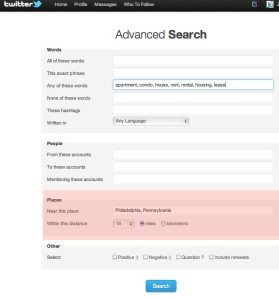
- Respond to every single person who follows you. Send them a direct message or reply thanking them for the follow and ask them how you can help them further.
- Write your tweets as tweets, don’t just link up your twitter with your facebook page and copy those posts. Different platforms demand different techniques. Twitter has a character limit, so every single word you type counts.
OTHER SOCIAL MEDIA SITES:
I wanted to touch on Twitter and Facebook for now because I find them to be the most popular, but look for another blog post in the future that goes over ways real estate professionals can use other social media sites such as Google+, LinkedIn, YouTube and Foursquare.
THREE MOST IMPORTANT POINTS SURROUNDING SOCIAL MEDIA USE:
Social media is supposed to be exactly that — social. You can’t just blast content to multiple sites daily. You should be striving for a certain amount of engagement, not just a certain number of facebook page likes or twitter follows. Create polls, ask questions, post photos and respond immediately whenever someone comments.
Know your story
What are you trying to promote? In what way do you want the public to view you? What type of message do you want the public to come away with when they see postings by you?
Know your audience
What types of content will engage them? What types of information do you think they will expect from you? You might think that posting once a day is enough, but if it isn’t meaningful content that creates engagement, no one is going to want to read it.
Know your goal
What is your purpose for being on each site? Leads are not generated just by simply signing up for a certain social media site and by posting irregularly or posting disengaging content . If you know what you want to gain out of it, you’ll be able to better adjust the techniques you’ll use to get there. Track your progress, set small goals like a certain number of followers or likes, a certain amount of engagement, posting something meaningful once a day, etc. How will you measure your success?
The more I write about this subject now, the more I realize the necessity for multiple posts about it, so check back again for more updates where I’ll explain a little deeper about individual sites – just wanted to hit the basics for now. We’re constantly striving to better our own social media practices and actively looking for ways to improve. Connect with our twitter, facebook and youtube accounts to see the changes as the happen.
Family-Friendly Activities Near Philadelphia PropertiesAll the rave about Philly city living seems to always be about the nightlife and the good food, but, as a former preschool teacher who is looking to establish a life in Philadelphia, I wanted to find out about the family-friendly, children accessible attractions that this wonderful city has to offer.
PLAYGROUNDS:
- Rittenhouse Square, at 18th and Walnut streets, has a small space for children to play in. What’s better is that it is a gorgeous place for adults to sit and enjoy each other’s company while the kids run out all their energy. The Park is surrounded by gorgeous prime Philadelphia real estate, which often aids as a shade from the sunshine.
- Delancey Park, at Delancey between 3rd and 4th streets has lots of sculptures for little ones to climb on and fountains for them to enjoy. Photo opportunities are a regular here. Nearby, Old City features historical Philadelphia properties.
MUSEUMS:
- The Franklin Institute has got to be the best! It is my fondest memory of a museum from growing up and I would recommend it to anyone. It is adult-friendly with tons of wondrous information, and you can check the kids in at the giant heart and explore for yourself. Also, check out and even dare to run the Philadelphia Art Museum’s steps. This is a great area, set right between the residential Fairmount area and the heart of center city. Lots of families live nearby, and there are even some available Philadelphia houses for sale listed right now.
- The Please Touch Museum is also a must-see attraction. It is more for the kids so you may have to put your needs aside, but it has the most wonderful exhibits for exploration and learning.
- One that you may not know of, The Philadelphia Doll Museum, has exhibits that span cultures and time periods. Although this is in close proximity to the Temple University housing area, there are also many families currently living and enjoying this Philly residential area.
HISTORY:
- Whether you’re revisiting these sites or taking the kids along for the first time, Independence National Historical Park is home to Independence Hall, the Liberty Bell, and the First Bank of the United States. You can read up on your history while your kids can collect stamps at various park sites and become an official Junior Ranger. On the border of Old City and Washington Square, check out the gorgeous real estate prospects and commercial real estate sites around the area.
SPORTS:
- If you need to get your sports fix in, go to Citizens Bank Park. You can catch a game and let your kids explore the Phanatic Phun zone or Phanatic Shoe Slide, where your child can enjoy and learn about our city’s true love for its sports teams. If you are an out-of-towner, there is a Holiday Inn Hotel in close proximity.
EATERIES:
- The Hard Rock Cafe Philadelphia site features fun decor and tons of Rock and Roll. This is a great stop for those with young kids through teenagers or young adults. The kids will love the food and, luckily, so will you. Many Philadelphia commercial real estate properties are nearby in the Market Street area, so get some window shopping in before or after lunch!
- Johnny Rockets is located in the heart of the South Street fun and is 1950-themed. Enjoy delicious milkshakes while you sing along with the oldies.
MUSIC:
- World Cafe Live features a concert series for kids called Peanut Butter and Jams. Check out this fun event that will leave you and your kids singing the whole way home. World Cafe is located in close proximity to University City housing and is a great hot spot.
- The Philadelphia Orchestra for Kids offers family concert series, and Sound all Around, which appeals to younger kids. The music is chosen just for youngsters and is a great way for you share in their learning the love for the arts.
So, it turns out this city isn’t just for adults, and that there are many things you can do with your little ones by your side. Makes for a good reason to make Philadelphia property investment and stay for awhile! Contact us if you’d like to speak about buying a home in Philadelphia near any one of these family-friendly attractions!
When is it the right time to move out and on?The Move Home After College
According to TimeNewsFeed, 85% of college grads are moving home with mom and dad post-graduation. With high unemployment rates, recent graduates are trying the higher education route or attempting to save money by staying under their parents roofs. Higher undergraduate school loan costs, the unpredictable job market, and the high-cost of living are all good reasons to take a few years and prepare yourself financially for the responsibility that getting your own place requires.
I am a huge proponent of moving home right after college, if the option is available to you. No one could prepare me for what came next, no matter how many times they tried to warn me. Bills came like clockwork and the college years were the last years before I became a 9 to 5er. But, I eventually found myself being stifled by living at home, and I know a lot of others end up with similar sentiments. It’s important for you to recognize when you’re using your parent’s house as a crutch, and when it is time to move on.
Where to search for your new home
- Philadelphia Property Management Company– Property management companies and rental agents are a great way to start your apartment search. They have access to 1000’s of apartments , homes, and condominium units through their local MLS, which might not otherwise have access too.
- Craigslist – Craigslist is a powerful tool with is useful for a wide range of searches. For real estate it is particularly useful, as there is a huge apartment rental section in addition to its rooms / shares and real estate for sale categories
- Zillow / Trulia / Hot pads – I lump these three together because they provide much of the same service, and often even syndicate the same listings. Use these sites as a last resource, as typically they do not give the best results.
Ways to be Flexible and Within Budget
These are some ways that will allow for you to land in a place that fits most of your needs.
- Living with other people can always help cut down your expenses. Be willing to take on a roommate or two to share the costs of utilities and furniture for the place.
- Look for a way that you can convert a bedroom into two. Find an inexpensive room divider and add a roommate that you’re able to share space with.
- If you find a property which is in your price range and has most of what you want, please don’t give it up because it’s missing one component. There probably is never going to be an absolutely perfect place and you could be giving up a space you really love and regretting it in the end.
- Don’t focus on only Center City. Look in the areas just around the center, for example Manayunk or South Philadelphia, because they offer just as much excitement and are usually half the price.
Have More Questions? Need More Answers?
Contact JG Real Estate today. Use the Live Chat option and we will do our best to help you find the place that you’ve been searching for. Or, feel free to give us a call at 215-467-4100 to speak directly. If you need help, the best way to get it is to ask!
From HiddencityPhila.org: Frankford Avenue Drawing More Than A Dozen New Projects
Amazing blog post by Ariel Diliberto of HiddencityPhila.org:
Frankford Avenue Drawing More Than A Dozen New Projects
Northern Liberties-based Domani Developers, about to break ground on Stable Flats at George and American Streets, has nearly a dozen projects completed, in progress, or proposed around the intersection of Frankford and Girard in Fishtown. Further up Frankford Avenue, Little Baby’s Ice Cream and the pizza shop Pizza Brain will be opening next spring. Filling in the middle of Frankford Avenue, the Pickled Heron, a BYO serving French fare, opened at the beginning of this year, and several other properties nearby have recently been purchased for commercial use.
Fifteen years ago, this corridor had essentially been abandoned. The commercial vacancy was “ridiculously high,” recounts Henry Pyatt, commercial corridor manager at New Kensington Community Development Corporation (full disclosure: I am an Americorps VISTA at NKCDC serving as Sustainable 19125 Project Coordinator).
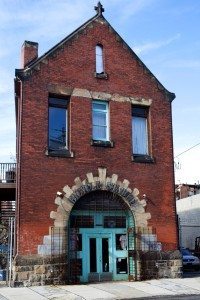
Bike Stable, 1420 Frankford Ave. | Photo: Peter Woodall
“People drove really fast in order to get through here,” said Pyatt. Now recent Domani projects along Frankford near Girard–Stephen Starr’s Frankford Hall, Lola Bean Café, Amarita Yoga, Art Machine tattoo parlor–as well as Bike Stable and the long-established Johnny Brenda’s, have begun drawing foot and bike traffic up the corridor. Pyatt compares the effects of these businesses to that of a straw, sucking business up from Girard and onto Frankford Avenue.
What’s in that straw, sliding up from Girard to Master Street? Here’s a review:
Domani Developers has proposed a hotel at the currently vacant five-story building, which was originally constructed as a brewery at the turn of the 20thcentury. After a brief stint as a pickle factory, the building served as a frozen storage facility operated by Arctic Cold Storage Co. beginning in 1925. Developer Roland Kassis, of Domani, envisions that the hotel will be like The Jane hotel in New York, with rates starting at $80 and running up to a couple hundred dollars per night.
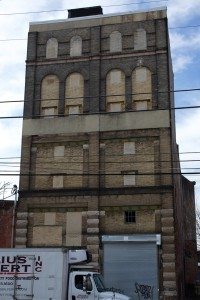
Former Arctic Cold Storage, possible boutique hotel, 1224 Frankford Ave. | Photo: Peter Woodall
Near Frankford and Mercer, Domani plans to create a 300-seat theater for plays, live music, comedy shows, and dinner, and an indoor, year-round farmer’s market—think mini-Reading Terminal. Prospective market vendors includeBaker’s Street Bread, a flower vendor, and of course, local farmers. There are plans for a restaurant and bar to be located inside the market, and Kassis also says that the Liquor Control Board was amenable to opening a retail outlet. Next door, construction will start soon on a salon, dubbed “The Parlor.” The farmer’s market and salon will both occupy parts of the old B & B Dyers complex, which was erected in several phases between 1865 and 1890 as an alcohol and cologne rectifying facility. From the 1920s onward the buildings served as a textile dying and finishing plant, which shut down in 1989.
Domani has also proposed opening a shop for the boutique motorcycle manufacturer Hammarhead, which builds custom-made hogs that run $40,000 a head. The company’s founder and CEO, James Loughead, Ph.D., is an Assistant Professor of neuropsychology at the University of Pennsylvania.
And there is more to come. Domani owns several more potential commercial spaces along Frankford Avenue. According to Kassis, Domani will often sit on a property for a year or more until they find a tenant they believe fits in with their vision for the neighborhood.
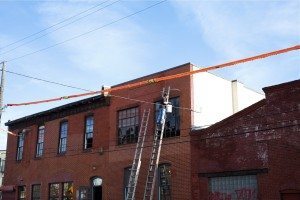
Former B&B Dyers, possible farmer’s market & salon, 1337 Frankford Ave. | Photo: Peter Woodall
A few blocks beyond the Domani properties, near Dauphin, Brian Dwyer and Joe Hunter will open Pizza Brain in a former flower shop, in conjuction with the opening of Little Baby’s Ice Creamnext door. Both will offer somewhat eccentric yet affordable fare.
Other indicators of future development include the recent sale of an old car wash at Norris, and Philadelphia Brewing Company’s purchase of the lot at Hagert located in front of their Brewery.
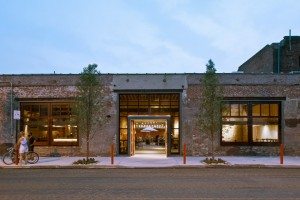
Frankford Hall, 1210 Frankford Avenue | Photo: Dan Cox
Lest it seems that the all this development is indistinguishable, I hasten to point out that the design, scale, and price points of proposed projects vary. The Domani projects near Girard will continue in the vein of the developers’ past projects on the Avenue, such as Frankford Hall, Amarita Yoga, and the Lola Bean. This means clear-coated brick, rough lumber, and other accents showing bones of old buildings, combined with more modern touches. It also means we can expect, at least to some degree, slightly higher price points. Further up the avenue, in a section of the neighborhood that still has a considerable number of vacant properties, a less flashy aesthetic has been maintained (even in the scattered residential development), with most businesses opening up in buildings in situ while offering products priced consistently with those of older neighborhood establishments.
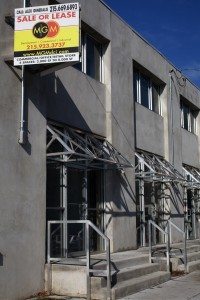
1306 Frankford Ave. | Photo: Peter Woodall
Do these developments serve as a microcosm of larger demographic trends in Fishtown? Depends who you talk to. While Kassis says that his projects are both citywide destinations and neighborhood places, Pyatt confirms that there certainly has been an increase in real estate values in the area around Frankford and Girard, an upward trend that dates back to the opening of Johnny Brenda’s in the early 2000s. There’s no denying that the neighborhood is experiencing “growing pains,” but, he adds, “this is a market economy, not a controlled economy.”
Johnny Brenda’s co-owner Paul Kimport points out that the monolithic label of “gentrification” does not accurately describe recent changes in Fishtown: the housing stock and open space available for development are limited, he observes. These conditions foster a more restrained level of development, preventing the neighborhood from being dominated by new construction projects, as has been the case in nearby Northern Liberties.
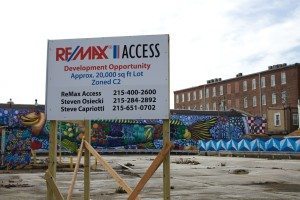
Frankford Ave. & E. Palmer St. | Photo: Peter Woodall
As for predictions looking forward, Kassis believes that in three years Frankford Avenue–1990s progenitor of the strategy of using grass, trees, and wooden fences to manage proliferating vacant land–will be unrecognizable. Drag racing and short dumping of trash will be only a distant memory. Pyatt shares a similar vision, but does not believe that the flashier architectural characteristics of Domani’s projects near Girard, with their higher cost per square foot, will necessarily extend all the way up the corridor. Supporting this speculation, Pizza Brain, Little Baby’s Ice Cream, and the Pickled Heron have stationed themselves in existing buildings without extensive exterior renovations, allowing them to blend comfortably with the surrounding fabric of the neighborhood.
According to Pyatt, the next step in solidifying Frankford Avenue as a retail district is to string together the two main nodes of commerce on the avenue. He is encouraging this process along with the rest of the economic development Department at NKCDC by marketing available properties and entreating Frankford Avenue property owners to consider renovations amenable to commercial use during the zoning process.
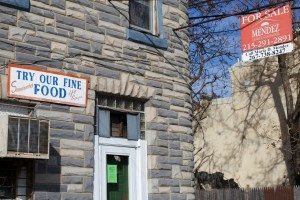
Frankford Ave. & E Jefferson St. | Photo: Peter Woodall
Kimport adds that in order to maintain the neighborhood’s sense of place and avoid displacement in the long run, policy change is necessary to prevent the real estate market from inflating prices. “There needs to be land value-based taxation for Philly,” he says, “or speculators will keep it from being what it could best be.”
Beyond participation in the community planning process, in this neighborhood community zoning meetings serve as the last venue for input from residents hoping to influence local development proposals. Last week, the Fishtown Neighbors Association (FNA) community zoning meeting unanimously approved the two variances will allow Little Baby’s Ice Cream to open their scoop shop and ice cream manufacturing location on Frankford Avenue. After Little Baby’s scooped up their community approval, a proposed two-family dwelling on a single-family lot received an overwhelming vote of opposition on the grounds that it “didn’t fit with the neighborhood” and would increase density to the inconvenience of neighbors. If this meeting was any indication, the community is both embracing (at least some) new commercial development while attempting to maintain the qualities of the neighborhood that predated the commercial revival on Frankford Avenue.
The community zoning meeting for the proposed theater, motorcycle manufacturer, hotel, and farmer’s market have yet to occur. If you live within the Fishtown Neighbors Association boundaries and would like to hear more details about the projects and weigh in, keep an eye on www.fishtown.org for the announcement of the community meeting date and time.

